Stress Prediction Model of Super-High Arch Dams during Their Initial Operation Stages
Abstract
1. Introduction
2. Calculation and Constructing Statistical Model for Stress of Super-High Arch Dams
2.1. Calculation of Measured Stresses of Concrete Dams
2.2. Prediction Models for Concrete Stress and Strain
2.2.1. Statistical Model of Stress-Free Strain
2.2.2. Statistical Model of Measured Stress
2.2.3. Boosted-Regression-Tree-Based Model for Measured Stress
2.3. Partial-Dependence-Plot-Based Variable Influence Analysis
3. Project and Stress Monitoring Description
3.1. Project Description
3.2. Initial Operation Process
3.3. Stress Monitoring
4. Stress Distribution and Variation Law Analysis
4.1. Stress Data Processing
4.2. Change Law Analysis of Stress-Free Strain
4.3. Analysis of Stress Distribution and Variation Law
4.3.1. Design Stress Distribution
4.3.2. Spatiotemporal Distribution Characteristics Based on Measured Data
4.3.3. Stress Distribution and Variation Characteristics of Crown Cantilever Monolith
5. Construction of Stress Safety Monitoring Model
5.1. Quantitative Analysis and Prediction Based on HTT and BRT Models
5.2. Stress Monitoring Index Based on Confidence Interval
5.3. Result Analyses and Discussions
6. Conclusions
- The stress was in a relatively compression state. The stress along the cantilever direction within the upstream restraint area was in a compressive state, and the region of greater compressive stress was located at the middle elevation. The maximum of the principal compressive stress appeared at the middle elevation of the upstream face of the crown cantilever monolith. After the reservoir was impounded, the arching compressive stress showed an increasing trend, and the arching effect was obvious.
- The fitting accuracy of the HTT model for the measuring points where the temperature was relatively stable and the stress was significantly affected by the RWL was higher, and vice versa. The BRT-based model can significantly improve prediction accuracy. The principal stresses of the measuring points at different elevations and different locations are affected by the environmental factors in different mechanisms. The cantilever direction stress at the dam heel of the crown cantilever is significantly affected by the interior temperature recovery, and the arch direction stress at the middle elevation of the upstream side is significantly affected by the RWL.
- The stress of the super-high arch dam during the initial operation stage is affected by several factors, such as the rise of the internal temperature and the change of the RWT, and frequently fluctuates. Therefore, because the stress of the super-high arch dam during this stage is also affected by the valley deformation, the measuring points of the key locations with reliable measurement values should be selected for stress analysis, model construction, and monitoring index determination to guide the initial operation. In the future, the influence of valley deformation should be also considered when analyzing the stress of a super-high arch dam.
- The dam is prone to expose safety problems during the initial operation stage. Super-high arch dams need to withstand huge water loads, safety monitoring during this stage is more important, and attention should be paid to stress and deformation monitoring within 3 years after reaching the normal RWL. In addition to global climate change, extreme meteorological events exhibit a trend of high frequency and intensity. For super-high arch dams that are sensitive to the environment, stress monitoring deserves more attention.
- Although this paper has conducted a relatively systematic analysis from several perspectives, namely, data conversion, stress distribution, and prediction model construction of key measurement monitoring points, considering the development of data mining and artificial intelligence technology, future research should focus on proposing more convenient data processing methods, better result display formats, and better interpretation methods.
Author Contributions
Funding
Data Availability Statement
Acknowledgments
Conflicts of Interest
References
- Wang, R.K. Key technologies in the design and construction of 300 m ultra-high arch dams. Engineering 2016, 2, 350–359. [Google Scholar] [CrossRef]
- Wu, S.Y.; Cao, W.; Zheng, J. Analysis of working behavior of Jinping-I Arch Dam during initial impoundment. Water Sci. Eng. 2016, 9, 240–248. [Google Scholar] [CrossRef]
- Jiang, H.; Zhang, C.-H.; Zhou, Y.-D.; Pan, J.-W.; Wang, J.-T.; Wu, M.-X.; Fan, Q.-X. Mechanism for large-scale canyon deformations due to filling of large reservoir of hydropower project. Sci. Rep. 2020, 10, 12155. [Google Scholar] [CrossRef] [PubMed]
- Cheng, L.; Liu, Y.R.; Yang, Q.; Pan, Y.W.; Lv, Z. Mechanism and numerical simulation of reservoir slope deformation during impounding of high arch dams based on nonlinear FEM. Comput. Geotech. 2017, 81, 143–154. [Google Scholar] [CrossRef]
- Prakash, G.; Sadhu, A.; Narasimhan, S.; Brehe, J.-M. Initial service life data towards structural health monitoring of a concrete arch dam. Struct. Control Health Monit. 2018, 25, e2036. [Google Scholar] [CrossRef]
- Hu, J.; Ma, F. Statistical modelling for high arch dam deformation during the initial impoundment period. Struct. Control Health Monit. 2020, 27, e2638. [Google Scholar] [CrossRef]
- Hu, J.; Ma, F. Comparison of hierarchical clustering based deformation prediction models for high arch dams during the initial operation period. J. Civil. Struct. Health Monit. 2021, 11, 897–914. [Google Scholar] [CrossRef]
- Tao, Z.; Liu, Y.; Yang, Q.; Wang, S. Study on the nonlinear deformation and failure mechanism of a high arch dam and foundation based on geomechanical model test. Eng. Struct. 2020, 207, 110287. [Google Scholar] [CrossRef]
- Liu, Y.; Zhang, G.; Zhu, B.; Shang, F. Actual working performance assessment of super-high arch dams. J. Perform. Constr. Facil. 2016, 30, 04015011. [Google Scholar] [CrossRef]
- Lin, P.; Zhou, W.; Liu, H. Experimental study on cracking, reinforcement, and overall stability of the Xiaowan Super-High Arch Dam. Rock Mech. Rock Eng. 2015, 48, 819–841. [Google Scholar] [CrossRef]
- Hellgren, R.; Malm, R.; Ansell, A. Performance of data-based models for early detection of damage in concrete dams. Struct. Infrastruct. Eng. 2021, 17, 275–289. [Google Scholar] [CrossRef]
- Panicker, K.J.; Nagarajan, P.; Thampi, S.G. Critical review on stress-sensitivity and other behavioral aspects of arch dams. In Advances in Civil Engineering; Singh, R.M., Sudheer, K.P., Kurian, B., Eds.; Lecture Notes in Civil Engineering; Springer: Singapore, 2021; Volume 83. [Google Scholar] [CrossRef]
- Liu, X.; Li, Z.; Sun, L.; Khailah, E.Y.; Wang, J.; Lu, W. A critical review of statistical model of dam monitoring data. J. Build. Eng. 2023, 80, 108106. [Google Scholar] [CrossRef]
- Bukenya, P.; Moyo, P.; Beushausen, H.; Oosthuizen, C. Health monitoring of concrete dams: A literature review. J. Civil. Struct. Health Monit. 2014, 4, 235–244. [Google Scholar] [CrossRef]
- Salazar, F.; Vicente, D.J.; Irazábal, J.; de-Pouplana, I.; Mauro, J.S. A review on thermo-mechanical modelling of arch dams during construction and operation: Effect of the reference temperature on the stress field. Arch. Comput. Methods Eng. 2020, 27, 1681–1707. [Google Scholar] [CrossRef]
- Li, B.; Han, X.; Yao, M.D.; Tian, J.; Zheng, Q. Quantitative analysis method for the importance of stress influencing factors of a high arch dam during the operation period using SPA–OSC–PLS. Struct. Control Health Monit. 2022, 29, e3087. [Google Scholar] [CrossRef]
- Zhang, G.X.; Liu, Y.; Zhou, Q.J. Study on real working performance and overload safety factor of high arch dam. Sci. China Ser. E 2008, 51, 48–59. [Google Scholar] [CrossRef]
- Lin, P.; Shi, J.; Zhou, W.Y.; Wang, R.-K. 3D geomechanical model tests on asymmetric reinforcement and overall stability relating to the Jinping I super-high arch dam. Int. J. Rock Mech. Min. Sci. 2018, 102, 28–41. [Google Scholar] [CrossRef]
- Luo, D.N.; Lin, P.; Li, Q.B.; Zheng, D.; Liu, H. Effect of the impounding process on the overall stability of a high arch dam: A case study of the Xiluodu dam, China. Arab. J. Geosci. 2015, 8, 9023–9041. [Google Scholar] [CrossRef]
- Alembagheri, M. A study on structural safety of concrete arch dams during construction and operation phases. Geotech. Geol. Eng. 2019, 37, 571–591. [Google Scholar] [CrossRef]
- Li, B.; Xu, J.; Xu, W.; Wang, H.; Yan, L.; Meng, Q.; Xie, W.-C. Mechanism of valley narrowing deformation during reservoir filling of a high arch dam. Eur. J. Environ. Civ. Eng. 2023, 27, 2411–2421. [Google Scholar] [CrossRef]
- Sheibany, F.; Ghaemian, M. Effects of environmental action on thermal stress analysis of Karaj Concrete Arch Dam. J. Eng. Mech. 2006, 132, 532–544. [Google Scholar] [CrossRef]
- Huang, Y.; Xiao, L.; Zhou, Y.; Ding, Y. How first-immersion age affects wet expansion of dam concrete: An experimental study. Int. J. Civ. Eng. 2021, 19, 441–451. [Google Scholar] [CrossRef]
- Feng, Y.Q.; Shen, S.M.; Li, J. Report of the Design Unit of Xiluodu Hydropower Station—Safety Monitoring Section; Chengdu Engineering Corporation Limited: Chengdu, China, 2014. (In Chinese) [Google Scholar]
- Hou, C.; Wei, Y.; Zhang, H.; Zhu, X.; Tan, D.; Zhou, Y.; Hu, Y. Stress Prediction Model of Super-High Arch Dams Based on EMD-PSO-GPR Model. Water 2023, 15, 4087. [Google Scholar] [CrossRef]
- Kang, F.; Liu, X.; Li, J.J. Temperature effect modeling in structural health monitoring of concrete dams using kernel extreme learning machines. Struct. Health Monit. 2020, 19, 987–1002. [Google Scholar] [CrossRef]
- Chouinard, L.E.; Bennett, D.W.; Feknous, N. Statistical analysis of monitoring data for concrete arch dams. J. Perform. Constr. Facil. 1995, 9, 286–301. [Google Scholar] [CrossRef]
- Greenwell, B.M. Pdp: An R package for constructing partial dependence plots. R J. 2017, 9, 421–436. [Google Scholar] [CrossRef]
- Jin, F.; Zhang, G.X.; Luo, X.; Zhang, C. Modelling autogenous expansion for magnesia concrete in arch dams. Front. Archit. Civ. Eng. China 2008, 2, 211–218. [Google Scholar] [CrossRef]
- Hu, J.; Ma, F. Zoned deformation prediction model for super high arch dams using hierarchical clustering and panel data. Eng. Comput. 2020, 37, 2999–3021. [Google Scholar] [CrossRef]
- Wang, S.; Xu, C.; Liu, Y.; Xu, B. Zonal intelligent inversion of viscoelastic parameters of high arch dams using an HEST statistical model. J. Civil. Struct. Health Monit. 2022, 12, 207–223. [Google Scholar] [CrossRef]
- Li, Z. Study on Control Criteria of Stress and Integrity Safety of Super-High Arch Dams. Master’s Thesis, Tsinghua University, Beijing, China, 2010. [Google Scholar]
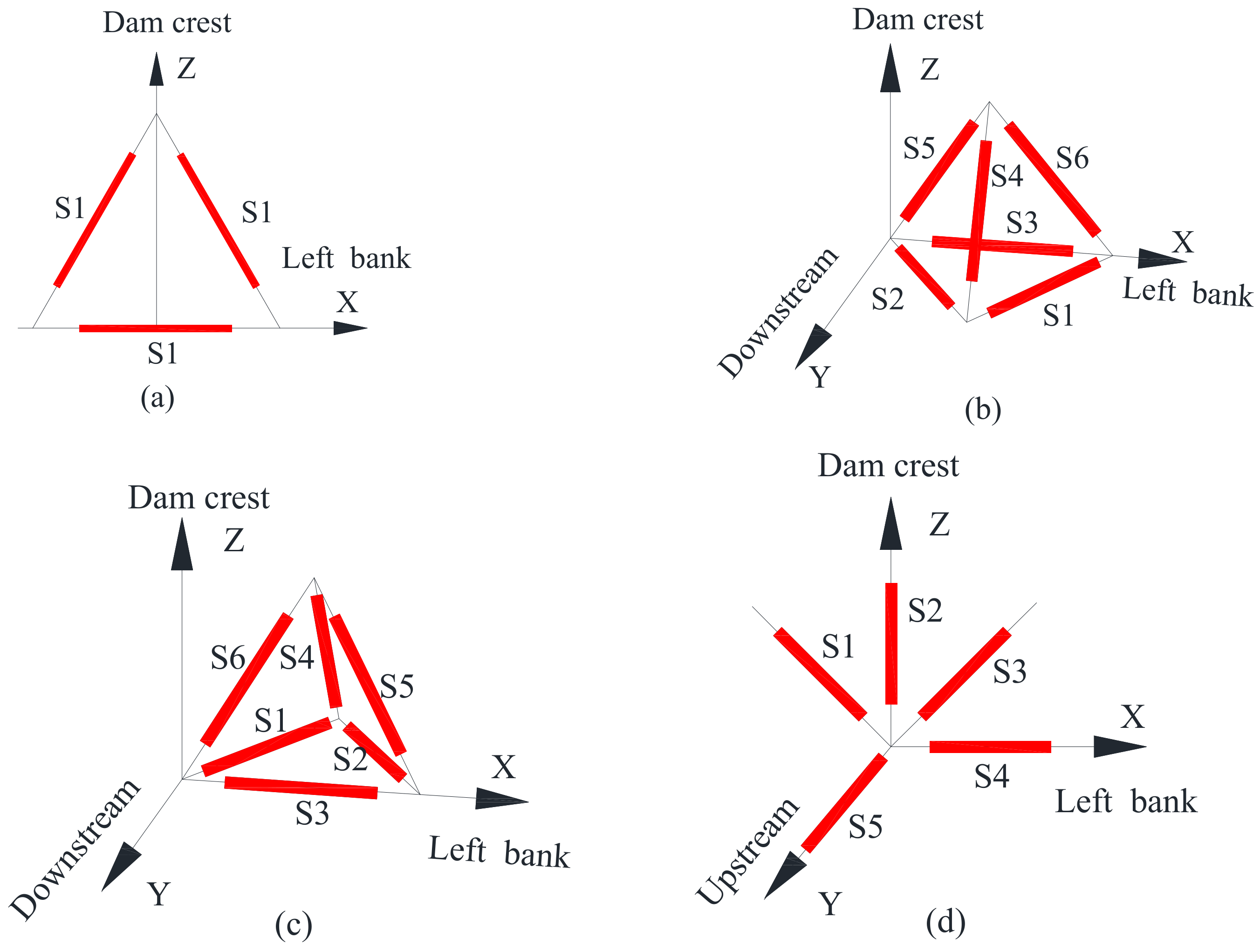
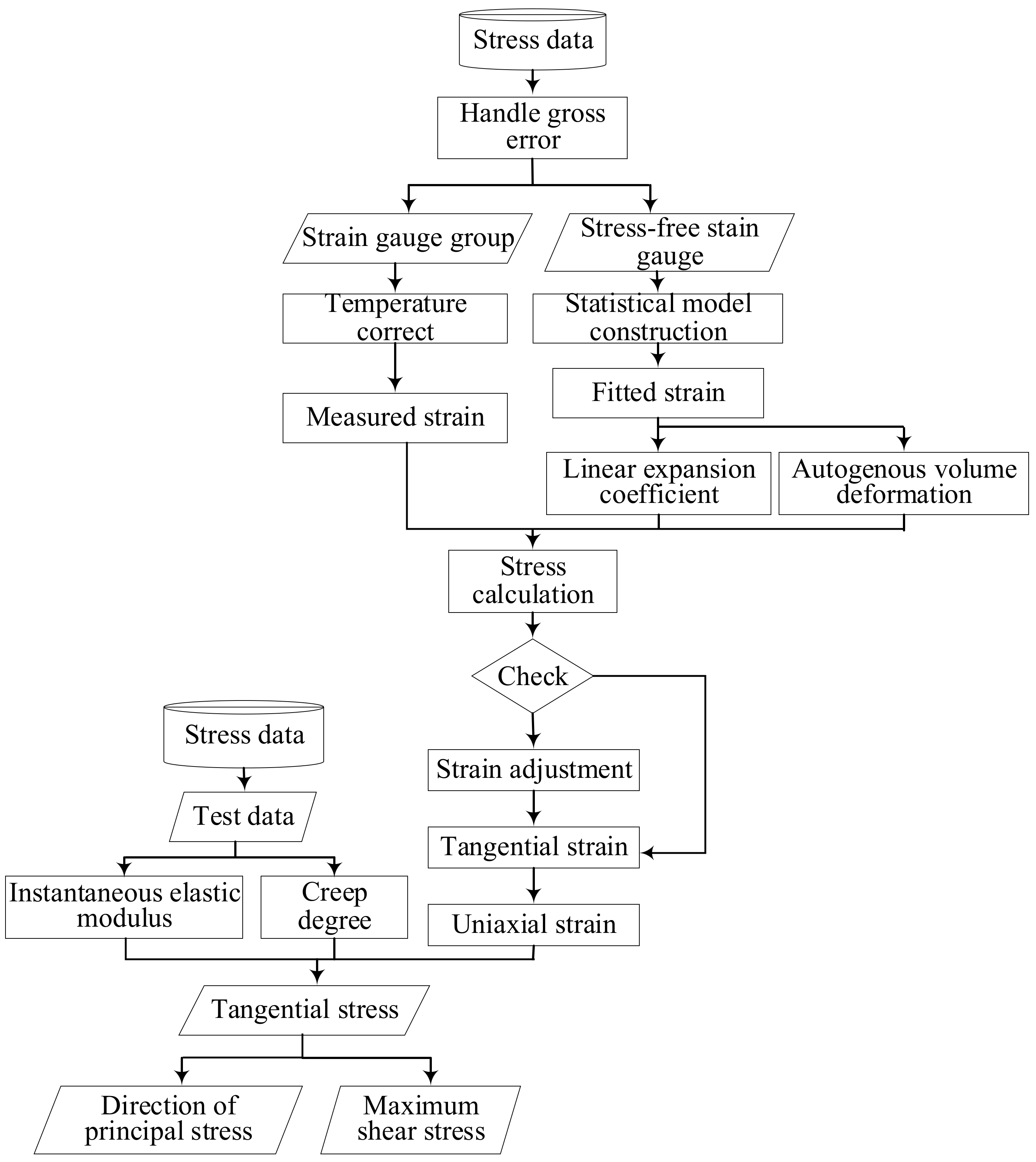
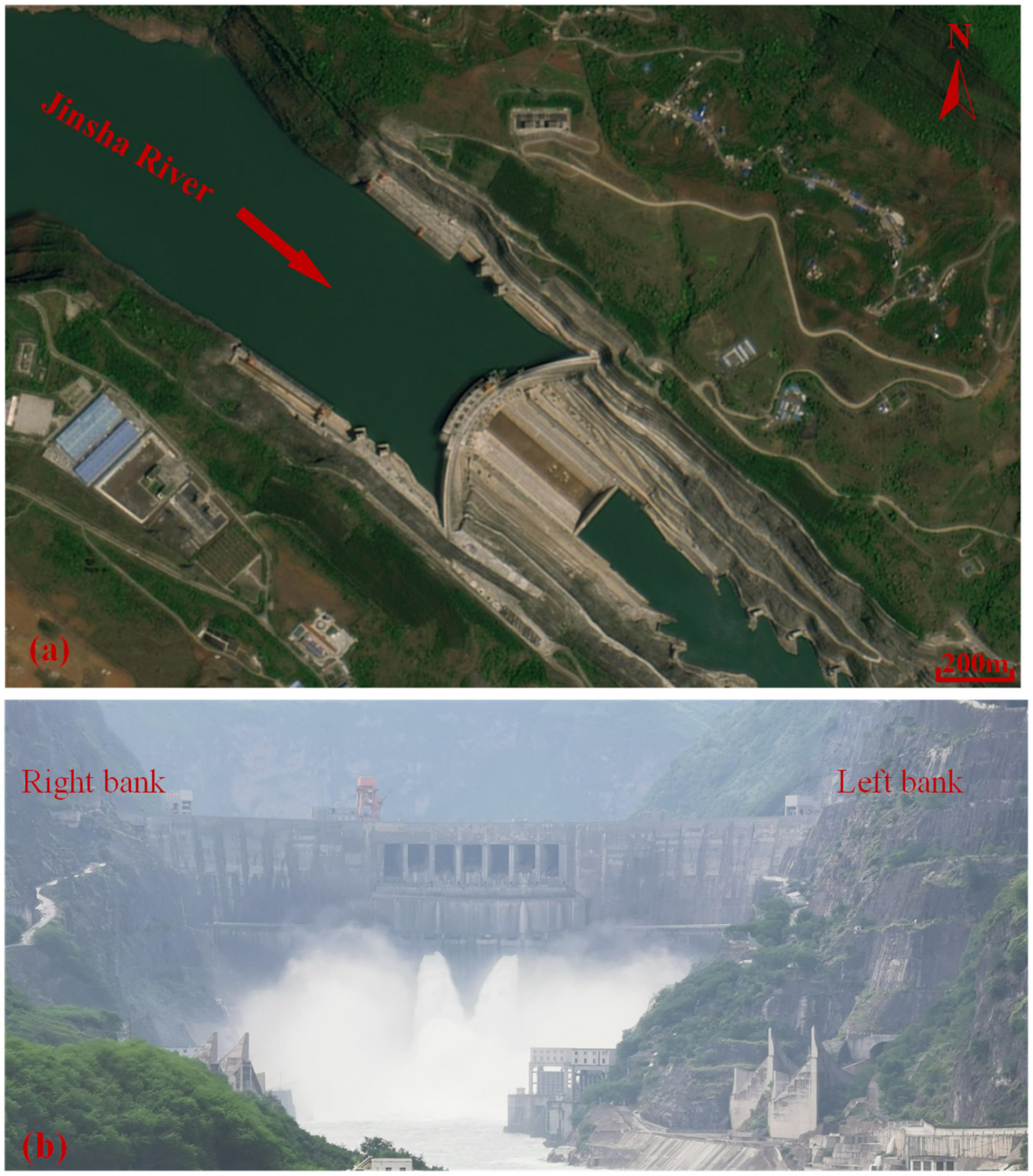
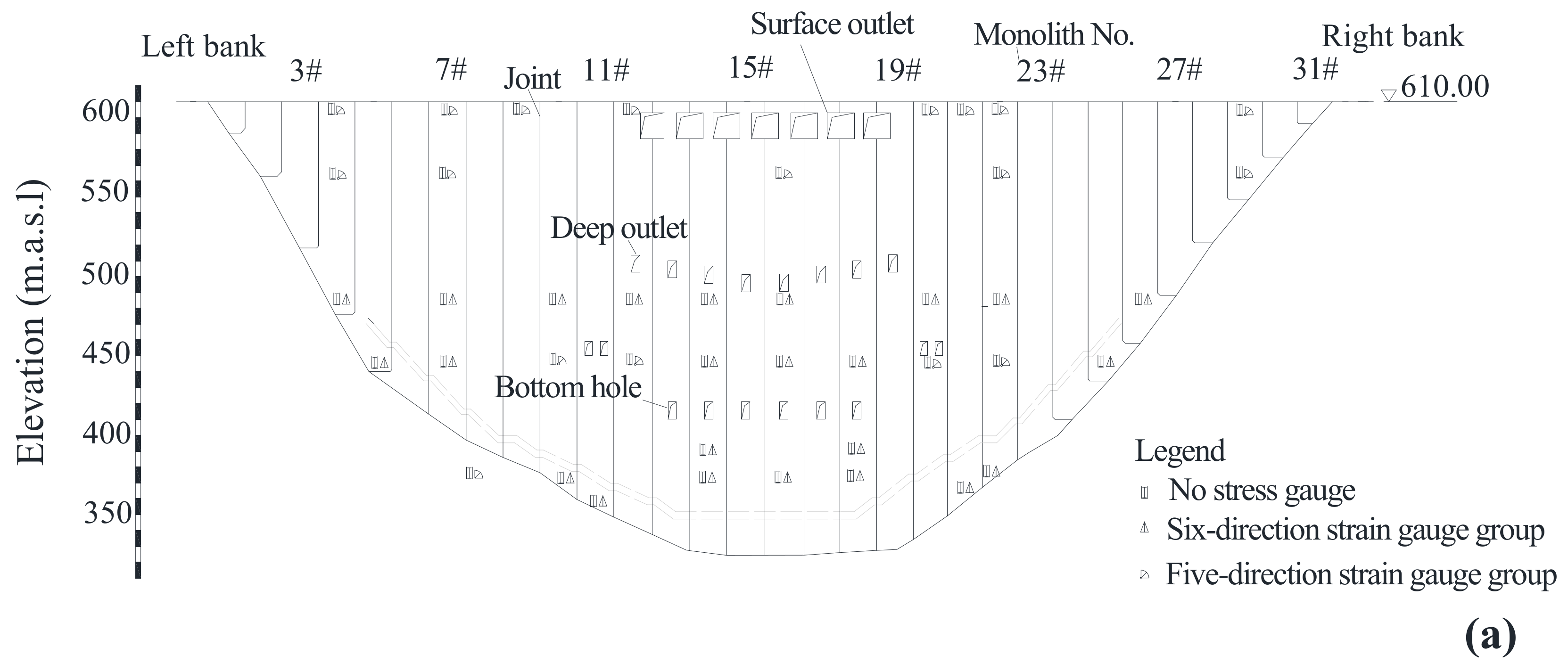
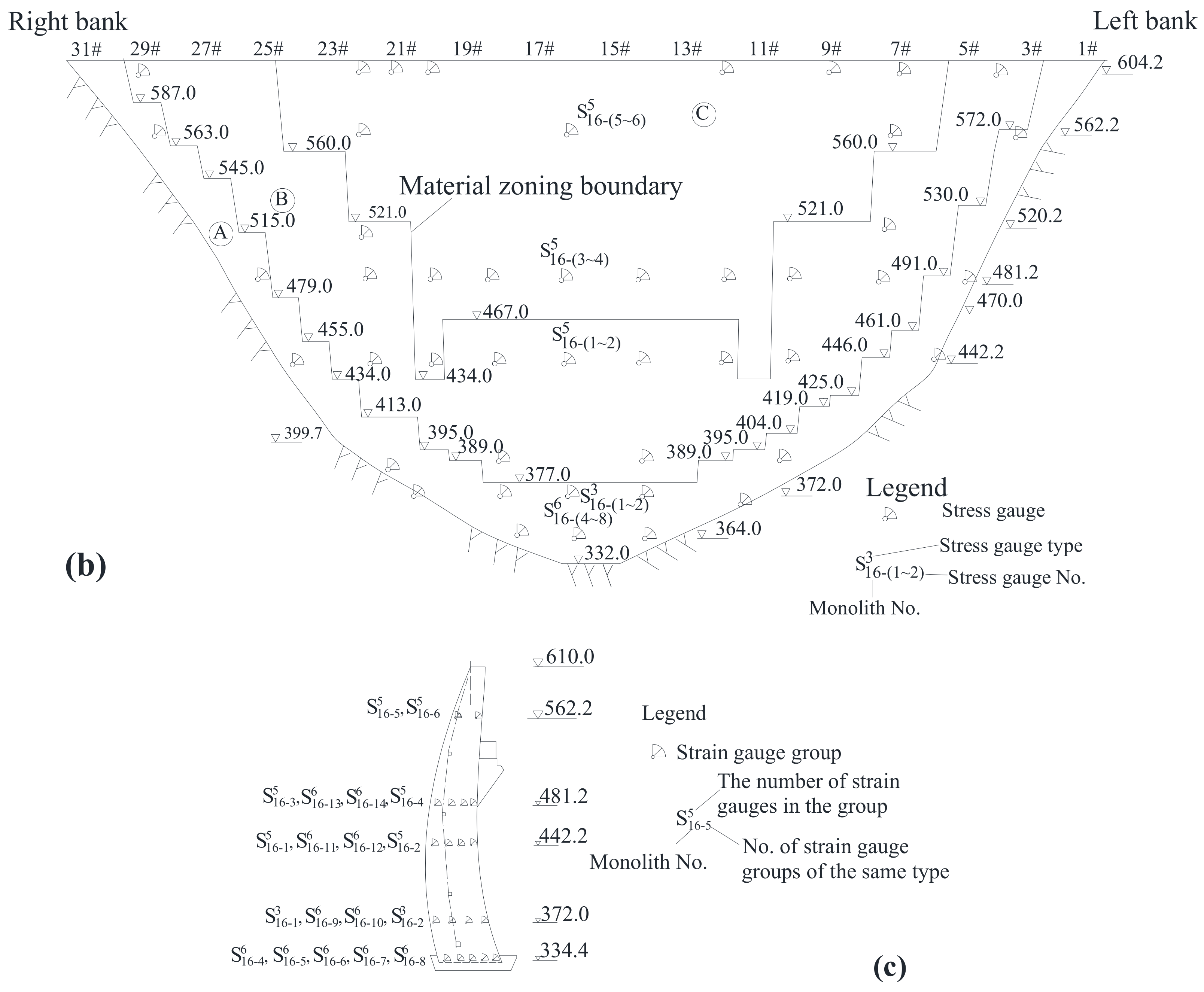
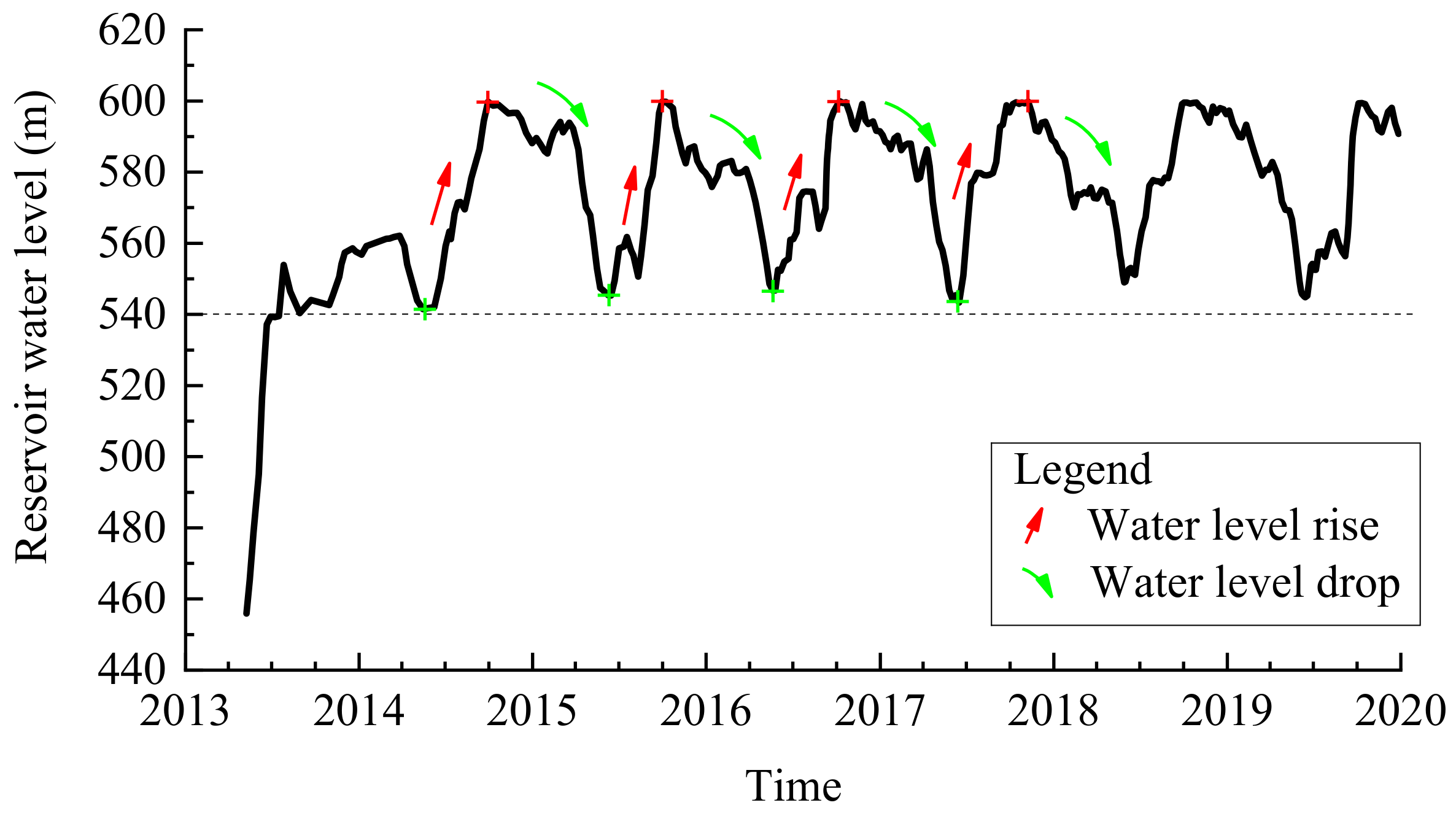
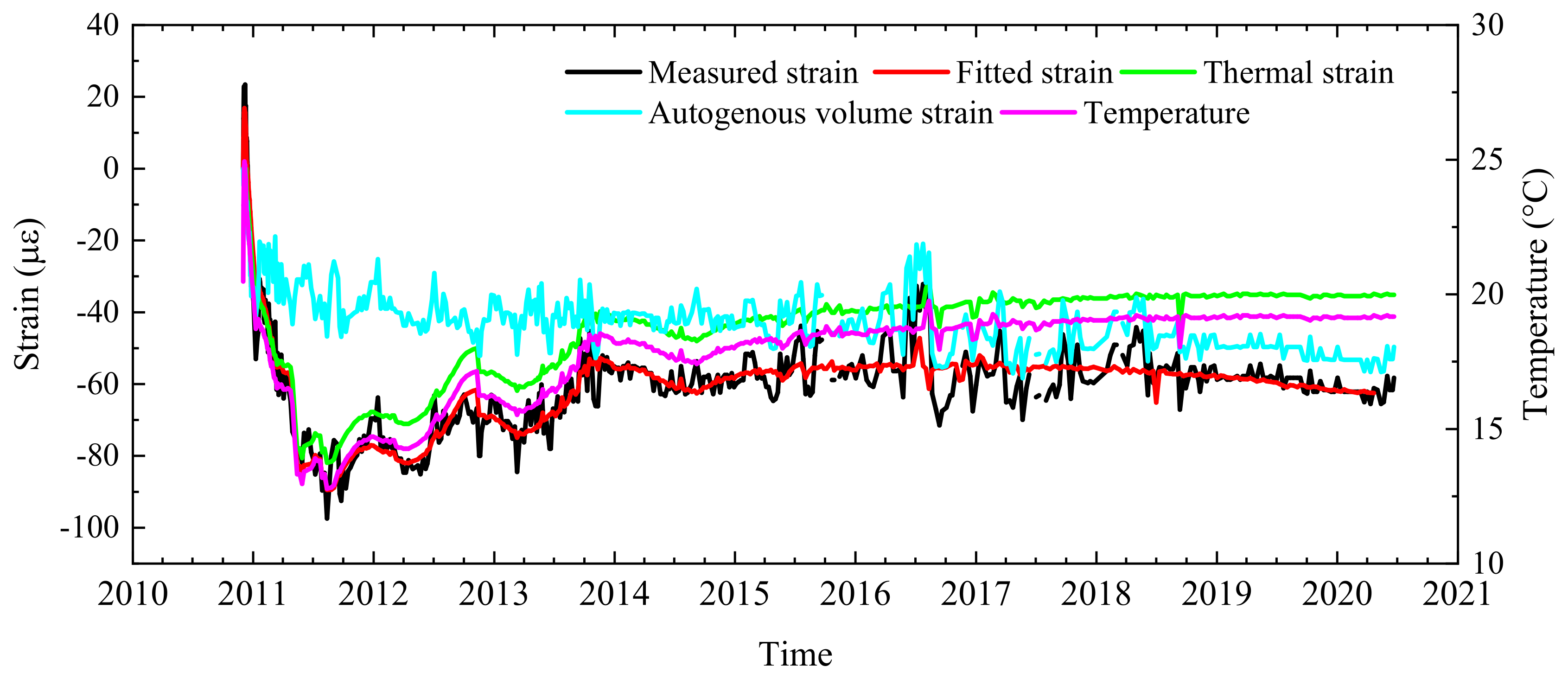
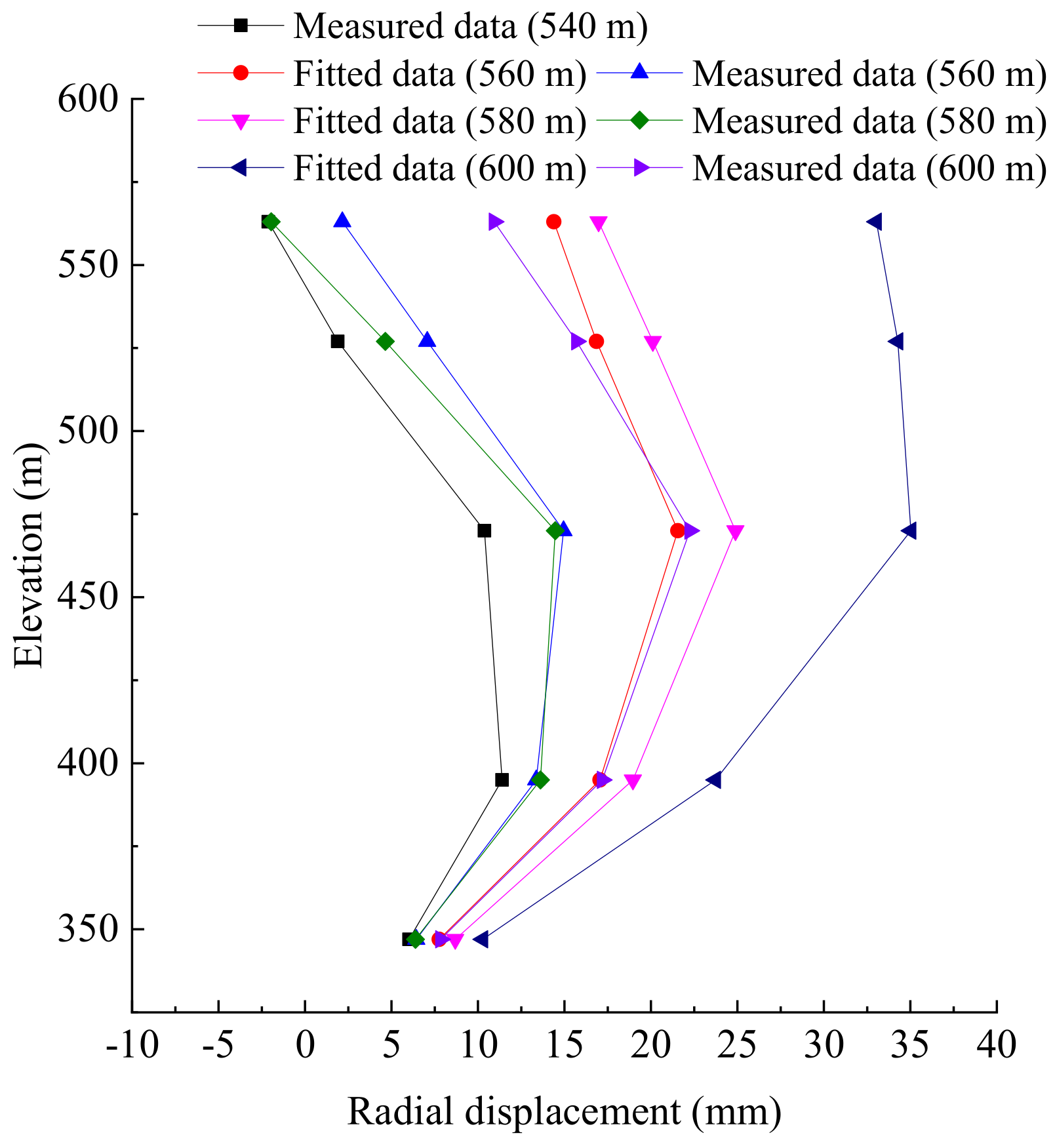
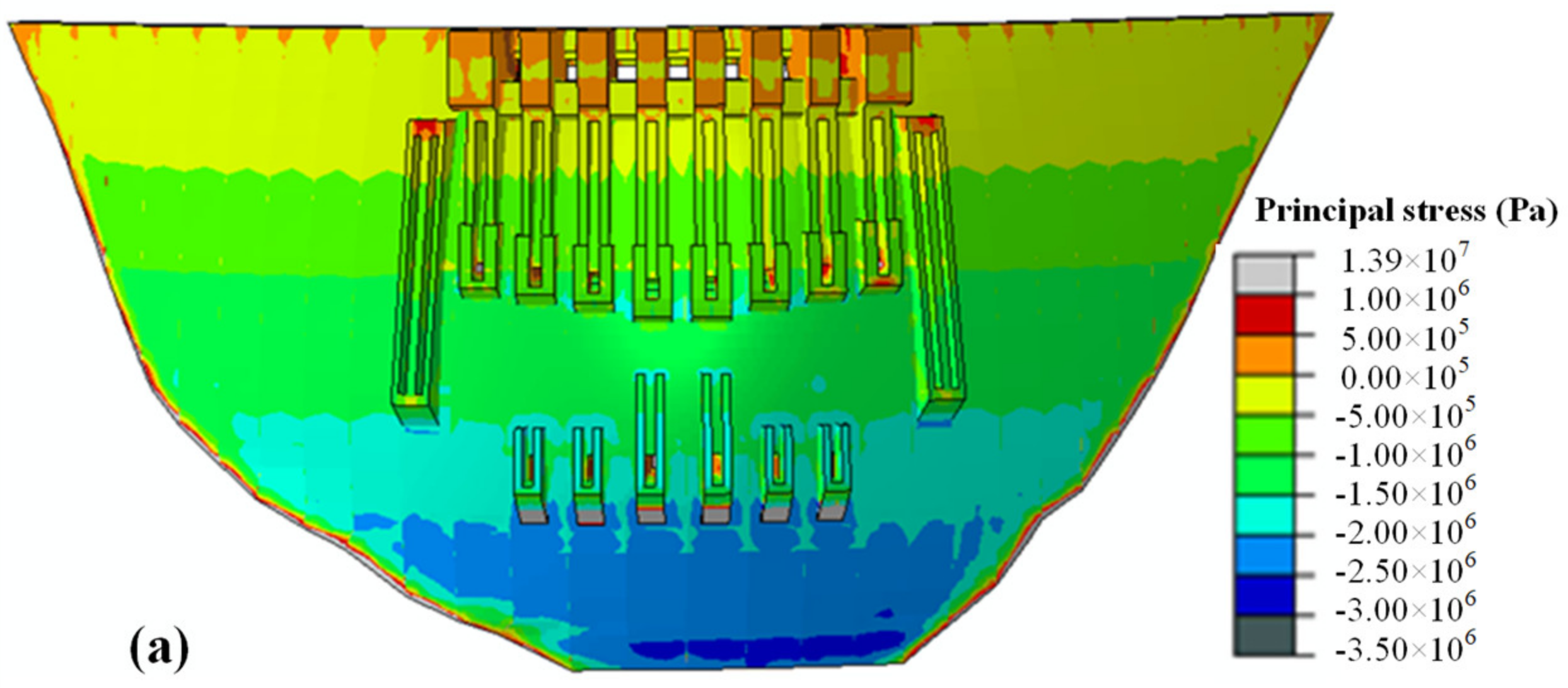
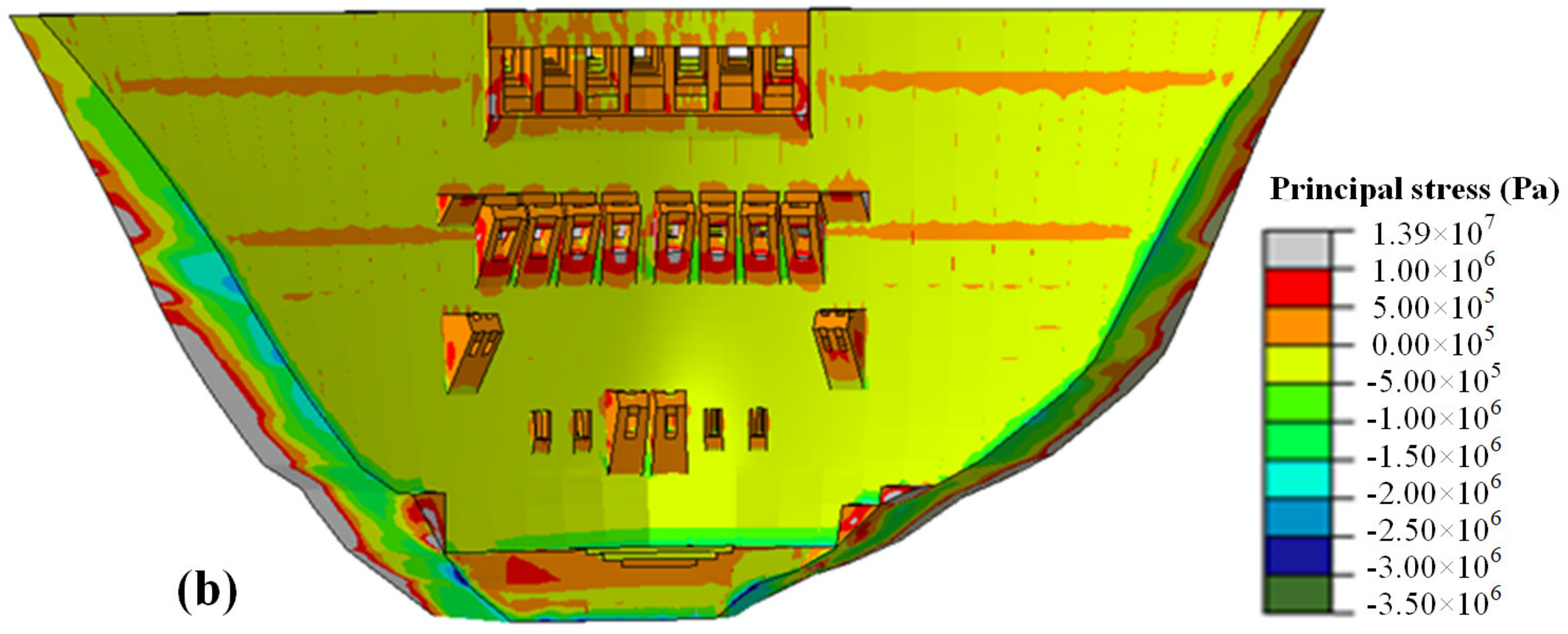
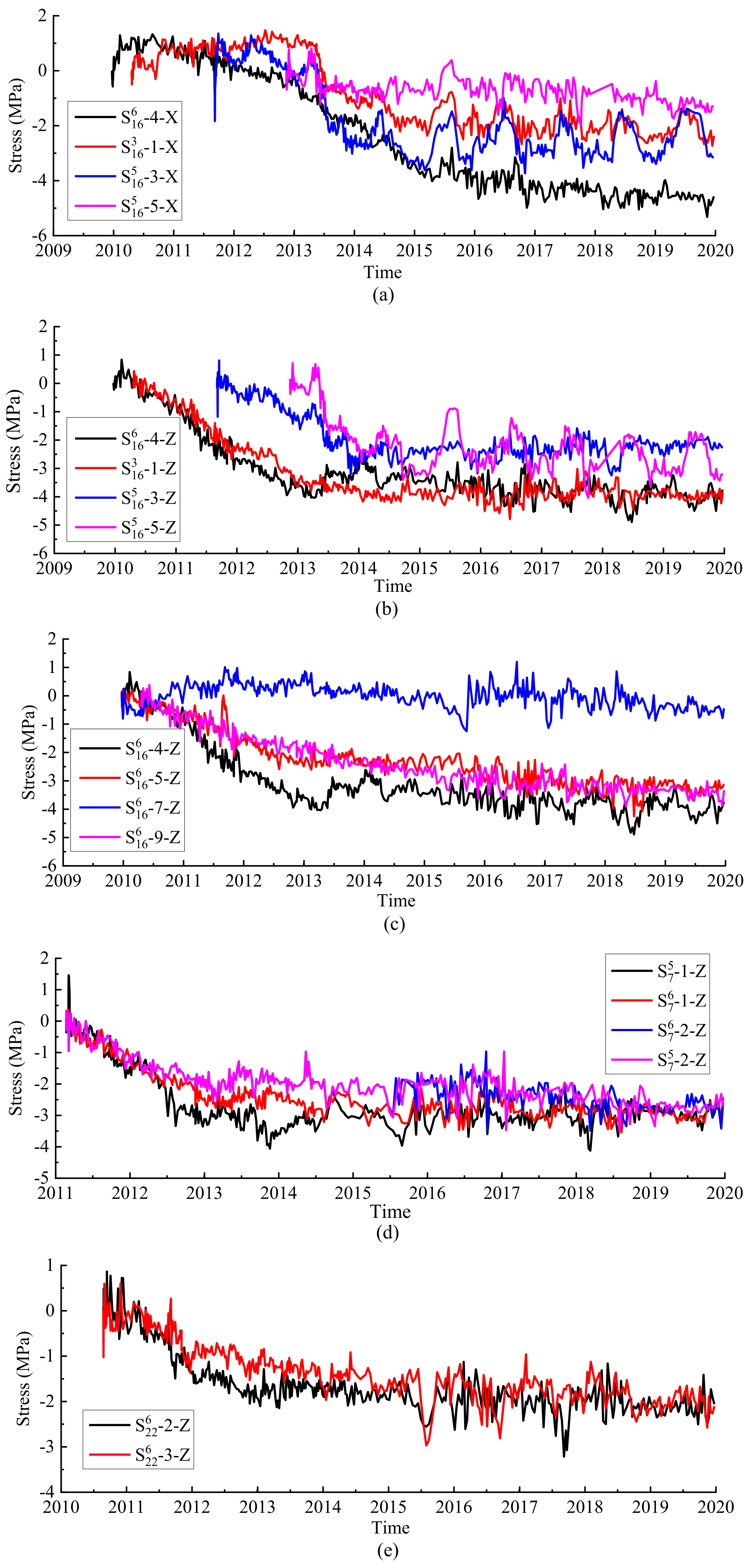
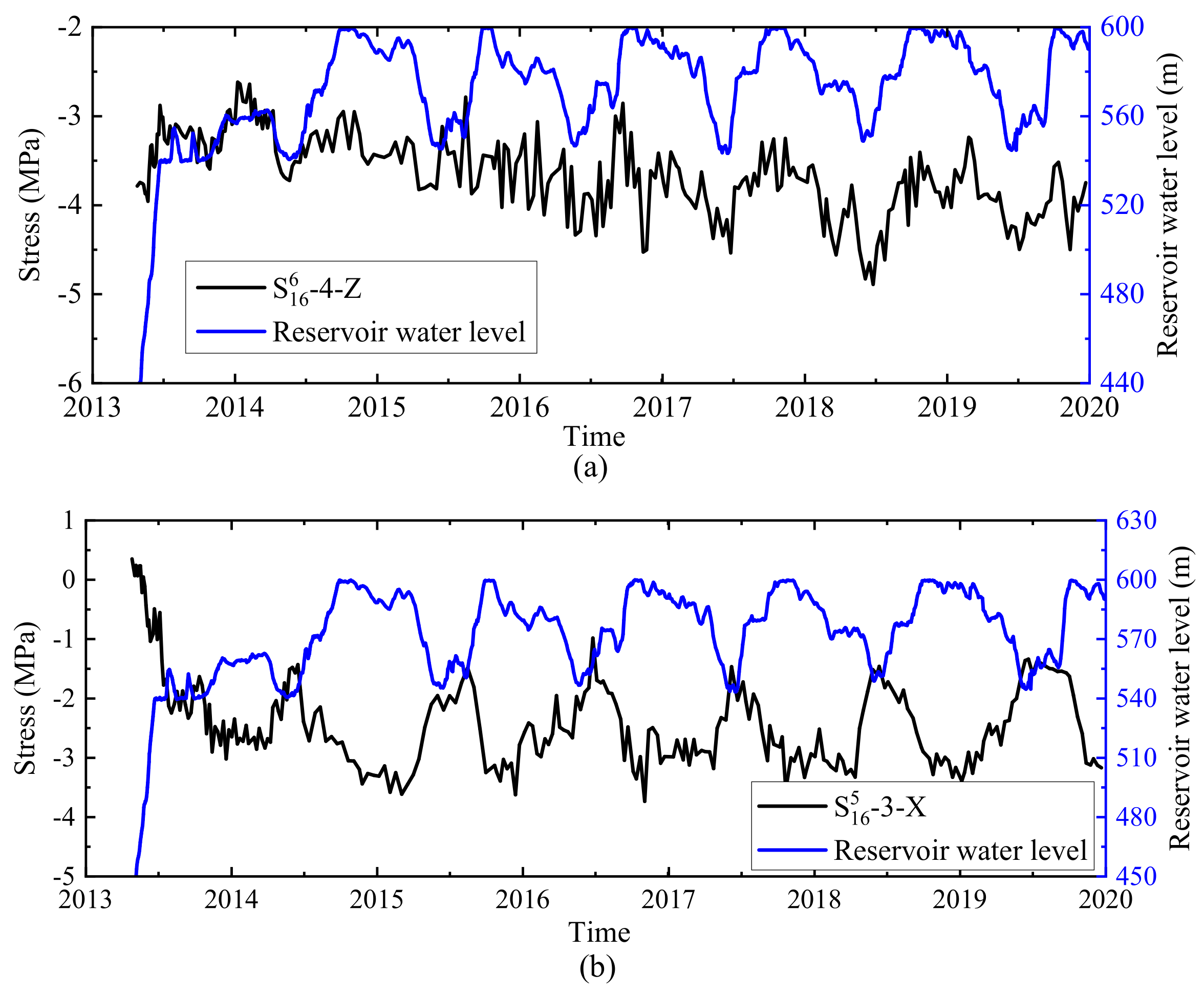
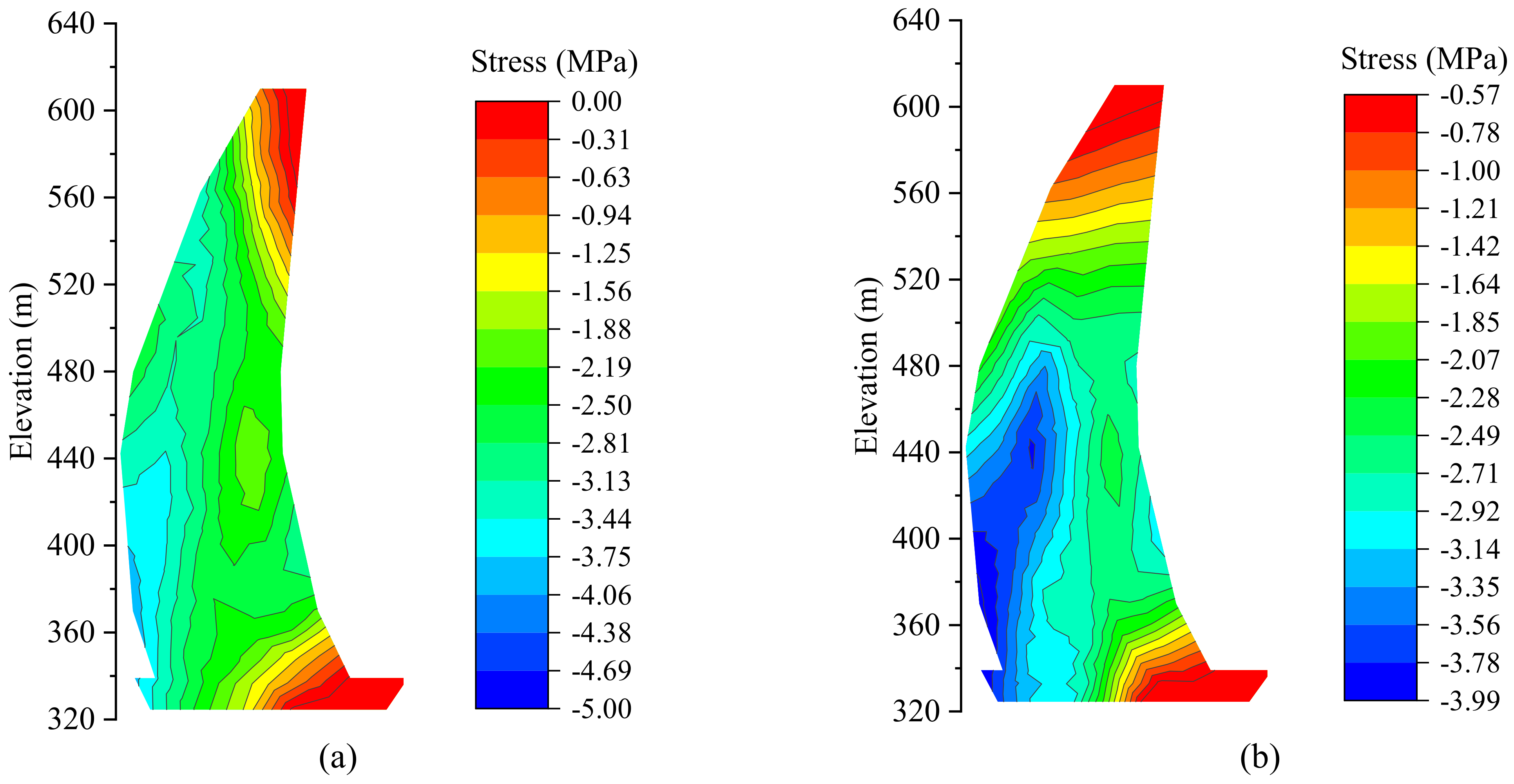
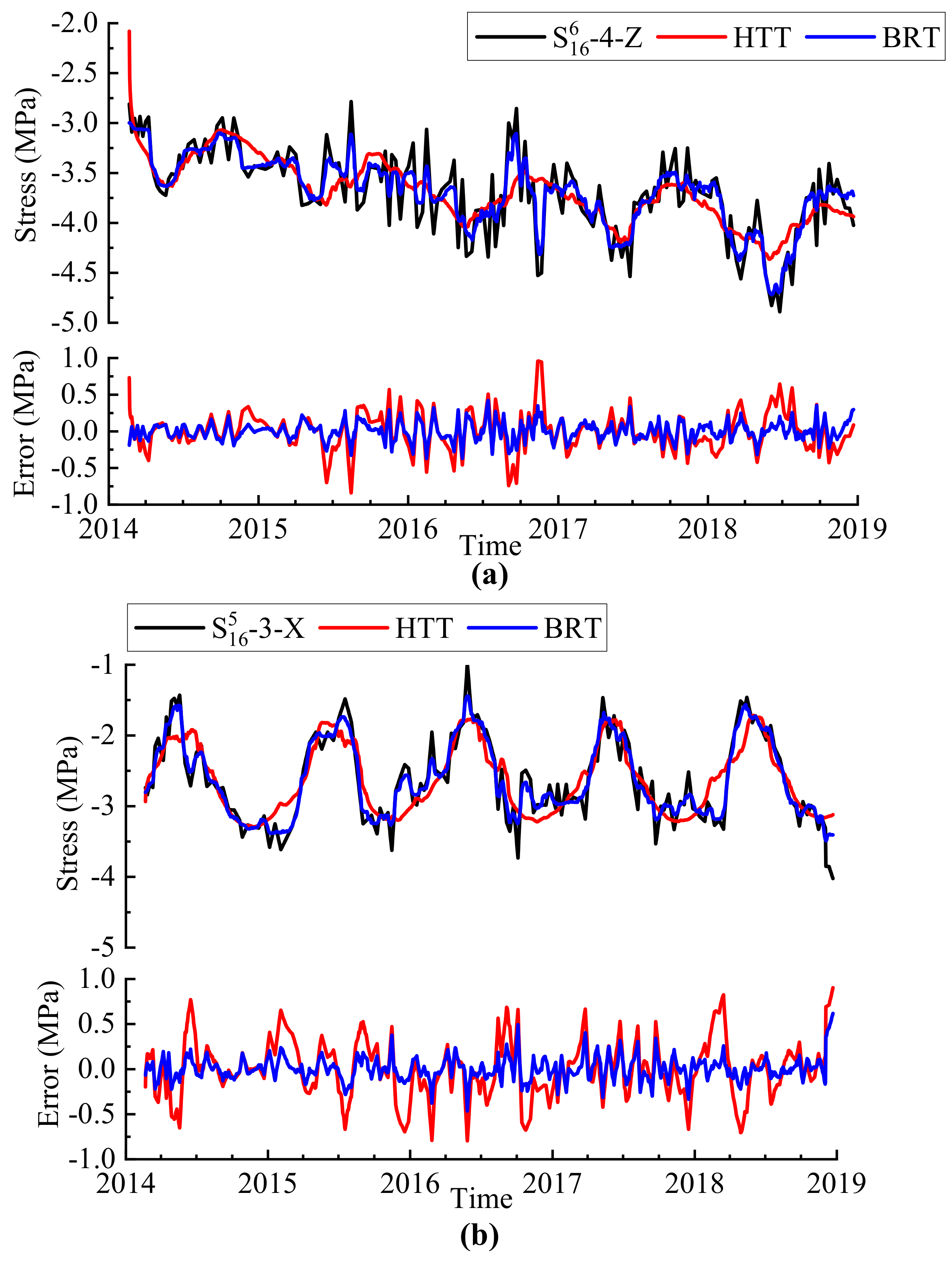
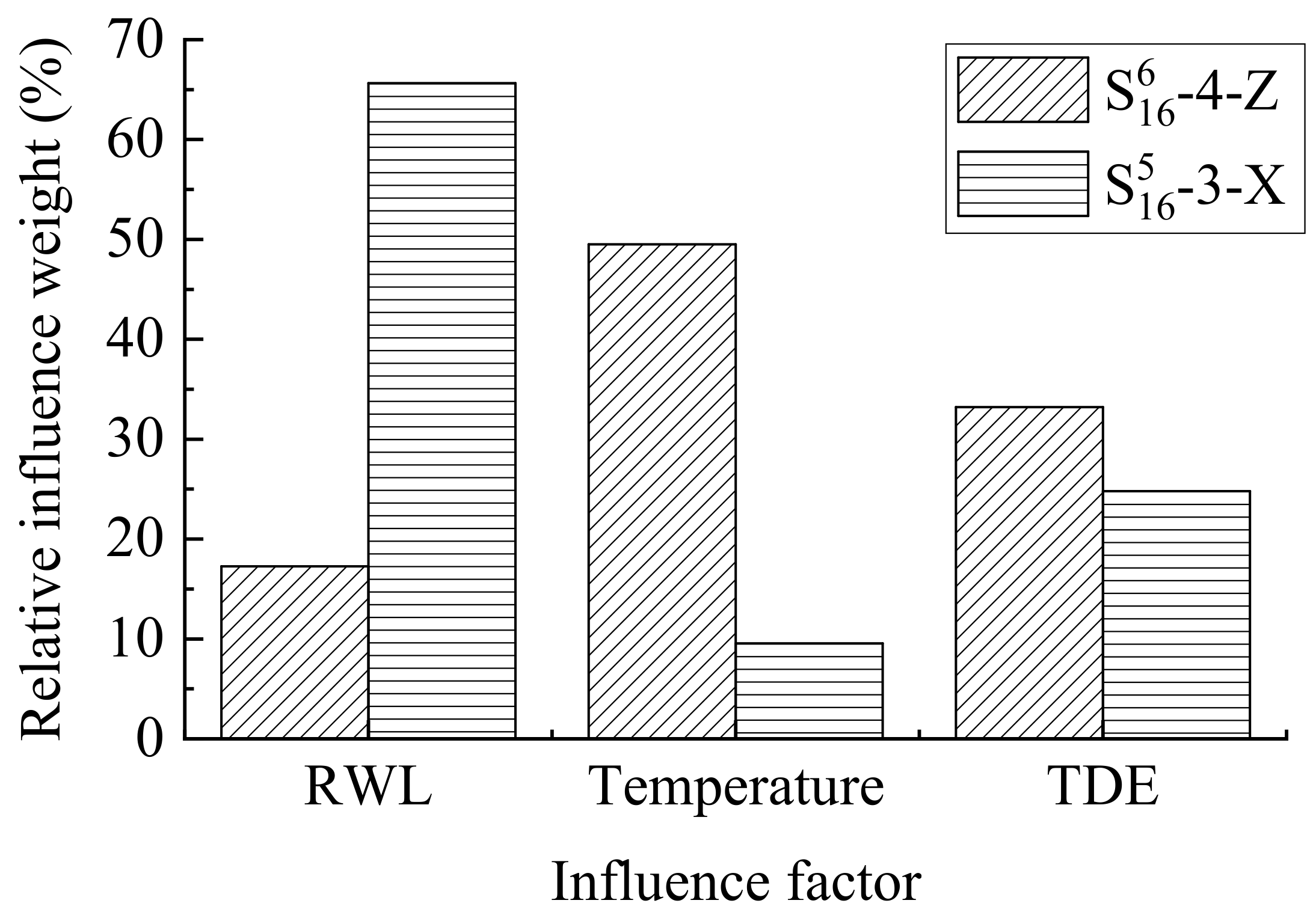
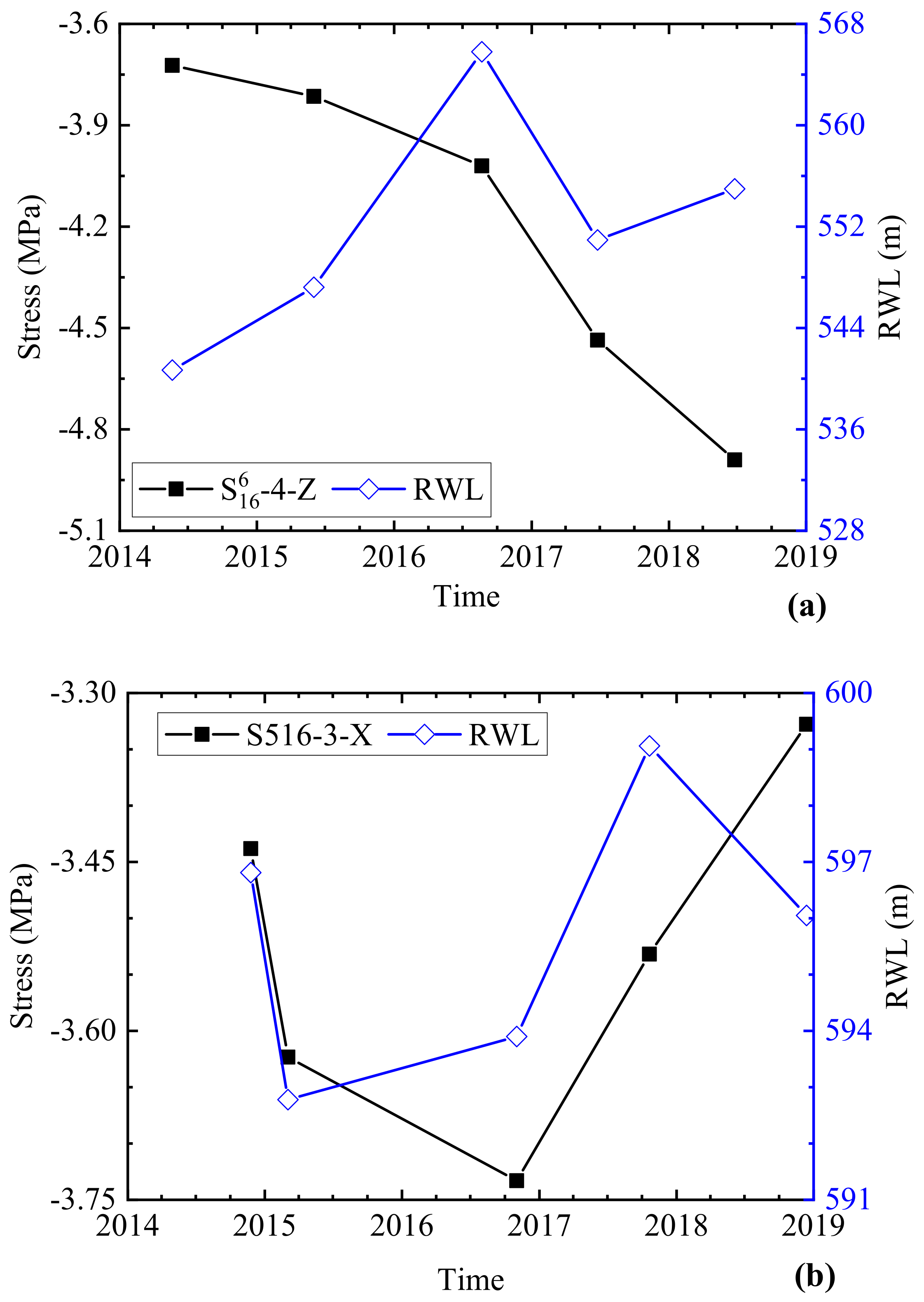
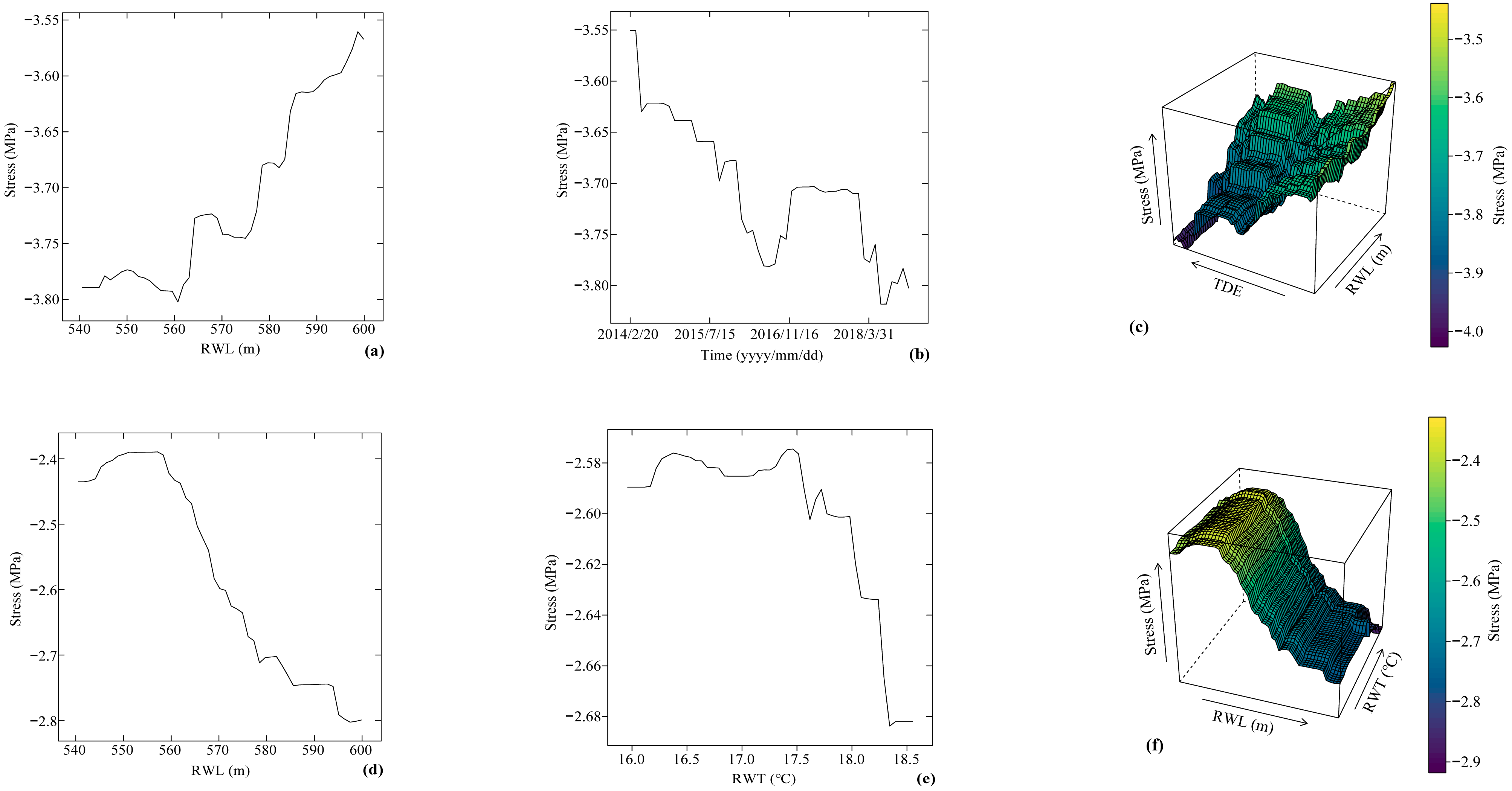
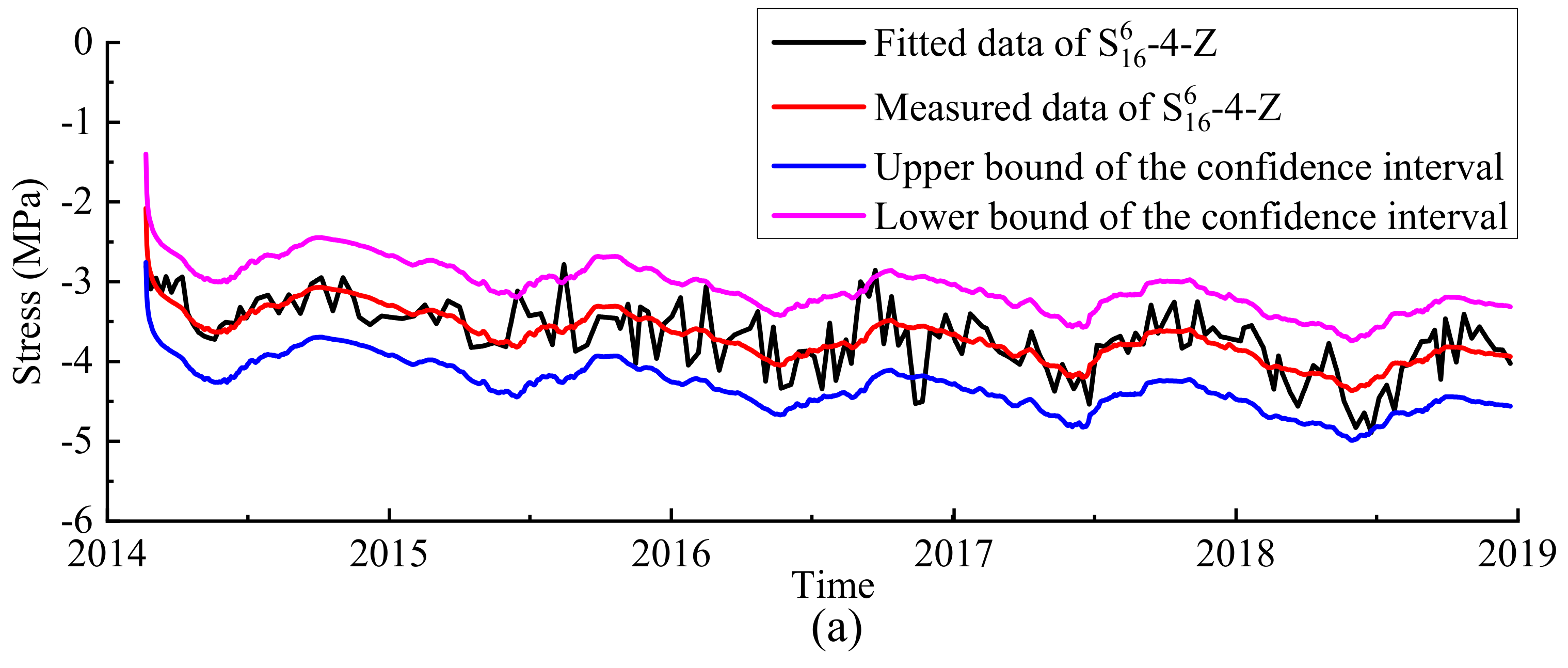
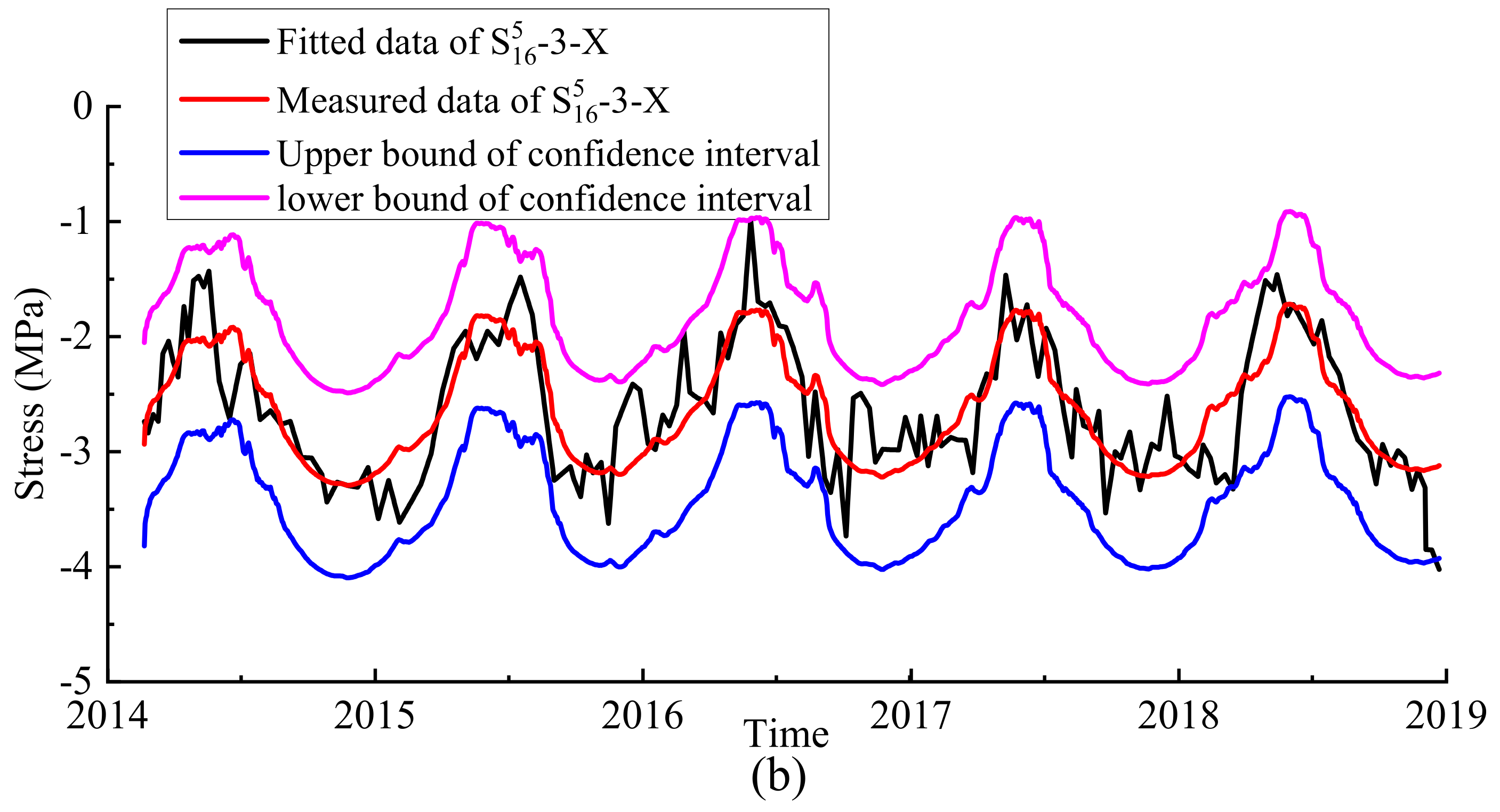
| Zone | A | B | C | Gate Pier and Orifice |
|---|---|---|---|---|
| Strength grade | C18040 | C18035 | C18030 | C9042 |
| Designed curing period (d) | 180 | 180 | 180 | 90 |
| Compressive strength (MPa) | ≥40 | ≥35 | ≥30 | ≥42 |
| Tensile strength (MPa) | ≥3.2 | ≥3.0 | ≥2.8 | ≥3.4 |
| Ultimate stretch (10−4) | ≥1.00 | ≥0.95 | ≥0.90 | ≥1.00 |
| Adiabatic temperature rise (°C) | ≤28 | ≤27 | ≤26 | ≤29 |
| autogenous volume deformation (10−6) | −20–10 | −20–10 | −20–10 | −20–10 |
| Concrete type | Normal | Normal | Normal | Normal |
| Concrete gradation | Two–four | Two–four | Two–four | Two, Three |
| Water–Cement Ratio | Fly Ash Content (%) | Compressive Elastic Modulus (GPa) | |||||||
|---|---|---|---|---|---|---|---|---|---|
| 1 d | 2 d | 3 d | 5 d | 7 d | 28 d | 90 d | 180 d | ||
| 0.41 | 35 | 8.8 | 17.7 | 24.1 | 28.5 | 31.8 | 35.9 | 42.5 | 43.4 |
| Zone | k1 | k2 | C1 | C2 | D1 | D2 | m1 | m2 |
|---|---|---|---|---|---|---|---|---|
| B | 0.7 | 0.05 | 0.05 | 1.33 | 38.11 | 39.62 | 0.55 | 0.59 |
| C | 0.6 | 0.04 | 1.26 | 1.05 | 42.31 | 39.25 | 0.49 | 0.52 |
| Point | HTT | BRT | ||||||
|---|---|---|---|---|---|---|---|---|
| Training | Prediction | Training | Prediction | |||||
| R2 | MAE (MPa) | R2 | MAE (MPa) | R2 | MAE (MPa) | R2 | MAE (MPa) | |
| S616-4-Z | 0.643 | 0.521 | 0.617 | 0.463 | 0.90 | 0.223 | 0.86 | 0.262 |
| S516-3-X | 0.787 | 0.311 | 0.706 | 0.384 | 0.96 | 0.085 | 0.91 | 0.216 |
Disclaimer/Publisher’s Note: The statements, opinions and data contained in all publications are solely those of the individual author(s) and contributor(s) and not of MDPI and/or the editor(s). MDPI and/or the editor(s) disclaim responsibility for any injury to people or property resulting from any ideas, methods, instructions or products referred to in the content. |
© 2024 by the authors. Licensee MDPI, Basel, Switzerland. This article is an open access article distributed under the terms and conditions of the Creative Commons Attribution (CC BY) license (https://creativecommons.org/licenses/by/4.0/).
Share and Cite
Cheng, R.; Han, X.; Wu, Z. Stress Prediction Model of Super-High Arch Dams during Their Initial Operation Stages. Water 2024, 16, 746. https://doi.org/10.3390/w16050746
Cheng R, Han X, Wu Z. Stress Prediction Model of Super-High Arch Dams during Their Initial Operation Stages. Water. 2024; 16(5):746. https://doi.org/10.3390/w16050746
Chicago/Turabian StyleCheng, Rongliang, Xiaofeng Han, and Zhiqiang Wu. 2024. "Stress Prediction Model of Super-High Arch Dams during Their Initial Operation Stages" Water 16, no. 5: 746. https://doi.org/10.3390/w16050746
APA StyleCheng, R., Han, X., & Wu, Z. (2024). Stress Prediction Model of Super-High Arch Dams during Their Initial Operation Stages. Water, 16(5), 746. https://doi.org/10.3390/w16050746





